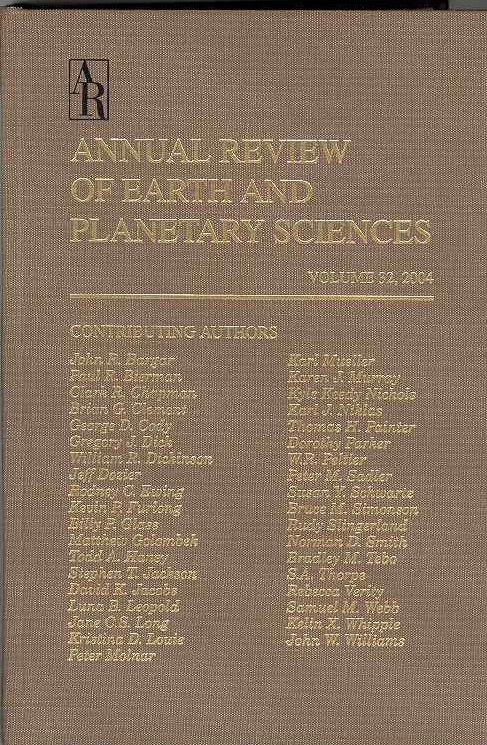奥陶系降温的原因与后果
IF 13
1区 地球科学
Q1 ASTRONOMY & ASTROPHYSICS
Annual Review of Earth and Planetary Sciences
Pub Date : 2025-02-27
DOI:10.1146/annurev-earth-040523-114630
引用次数: 0
摘要
氧同位素数据记录了奥陶纪(487 ~ 443 Ma)的长期降温趋势。早奥陶世的热带海洋盆地温度较高,由于氧溶解度对温度的依赖性,导致海洋表面氧浓度较低。升高的温度也增加了代谢需求,如微生物主导的碳酸盐记录的那样,热浅水环境限制了动物多样性。随着奥陶纪海洋降温,动物多样性增加,导致了奥陶纪生物多样性大事件。降温的延续性表明它是构造边界条件渐进式变化的产物。在这一时期,低纬度弧与大陆的碰撞可能增加了全球的耐候性,降低了大气中的二氧化碳水平。此外,大陆弧岩浆活动的减少可能降低了二氧化碳脱气通量。奥陶纪的长期降温趋势随着冈瓦纳大陆南极大冰盖的形成而达到顶峰。奥陶纪末期2 Myr主要冰的生长和衰减的时间尺度与轨道强迫驱动的类似更新世的冰期旋回相一致。大尺度冰期持续时间短,表明冰体积对温度的敏感性高,具有强烈的非线性响应,为新近纪和未来的气候变化提供了有价值的模拟。▪氧同位素数据记录了奥陶纪的渐进和长期冷却,导致了Hirnantian冰期的开始。▪奥陶纪辐射反映了生物多样性的逐渐冷却趋势,与温度依赖性氧溶解度和代谢作为主要控制因素相一致。▪长期变冷与低纬度弧-陆碰撞和全球耐候性增加同时发生。虽然CO2放气量也可能随着奥陶纪大陆弧长减少而减少,但在现代,CO2放气量沿大陆弧和岛弧都是变化的,这使得大陆弧长与气候之间的关系不确定。▪冰的显著增长的证据仅限于小于2迈尔的希尔南天阶段,这表明冰的增长对二氧化碳分压和温度的高度敏感性。■对希尔南天冰期极大期的冰量、面积和海平面变化的独立估计在内部是一致的,并可与末次冰期极大期相比较。本文章由计算机程序翻译,如有差异,请以英文原文为准。
The Causes and Consequences of Ordovician Cooling
A long-term cooling trend through the Ordovician Period, from 487 to 443 Ma, is recorded by oxygen isotope data. Tropical ocean basins in the Early Ordovician were hot, which led to low oxygen concentrations in the surface ocean due to the temperature dependence of oxygen solubility. Elevated temperatures also increased metabolic demands such that hot shallow water environments had limited animal diversity as recorded by microbially dominated carbonates. As the oceans cooled through the Ordovician, animal biodiversity increased, leading to the Great Ordovician Biodiversification Event. The protracted nature of the cooling suggests that it was the product of progressive changes in tectonic boundary conditions. Low-latitude arc-continent collisions through this period may have increased global weatherability and decreased atmospheric CO2 levels. Additionally, decreasing continental arc magmatism could have lowered CO2 outgassing fluxes. The Ordovician long-term cooling trend culminated with the development of a large south polar ice sheet on Gondwana. The timescale of major ice growth and decay over the final 2 Myr of the Ordovician is consistent with Pleistocene-like glacial cycles driven by orbital forcing. The short duration of large-scale glaciation indicates a high sensitivity of ice volume to temperature with a strongly nonlinear response, providing a valuable analog for Neogene and future climate change. ▪ Oxygen isotope data record progressive and protracted cooling through the Ordovician leading up to the onset of Hirnantian glaciation. ▪ The gradual cooling trend is mirrored by an Ordovician radiation in biological diversity, consistent with temperature-dependent oxygen solubility and metabolism as a primary control. ▪ Long-term cooling occurred in concert with low-latitude arc-continent collisions and an increase in global weatherability. Although CO2 outgassing may have also decreased with an Ordovician decrease in continental arc length, in the modern, CO2 outgassing is variable along both continental and island arcs, leaving the relationship between continental arc length and climate uncertain. ▪ Evidence for significant ice growth is limited to less than 2 Myr of the Hirnantian Stage, suggesting a high sensitivity of ice growth to p CO2 and temperature. ▪ Independent estimates for ice volume, area, and sea level change during the Hirnantian glacial maximum are internally consistent and comparable to those of the Last Glacial Maximum.
求助全文
通过发布文献求助,成功后即可免费获取论文全文。
去求助
来源期刊

Annual Review of Earth and Planetary Sciences
地学天文-地球科学综合
CiteScore
25.10
自引率
0.00%
发文量
25
期刊介绍:
Since its establishment in 1973, the Annual Review of Earth and Planetary Sciences has been dedicated to providing comprehensive coverage of advancements in the field. This esteemed publication examines various aspects of earth and planetary sciences, encompassing climate, environment, geological hazards, planet formation, and the evolution of life. To ensure wider accessibility, the latest volume of the journal has transitioned from a gated model to open access through the Subscribe to Open program by Annual Reviews. Consequently, all articles published in this volume are now available under the Creative Commons Attribution (CC BY) license.
 求助内容:
求助内容: 应助结果提醒方式:
应助结果提醒方式:


